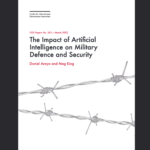How Model Inversion Attacks Compromise AI Systems

Table of Contents
In the age of big data and machine learning, artificial intelligence (AI) has evolved to play an indispensable role in a wide array of high-stakes domains, from computational biology and quantitative finance to real-time control systems in autonomous vehicles. However, the efficacy of AI hinges not just on its predictive accuracy, but also on the robustness and security of the underlying algorithms. One glaring vulnerability that threatens to compromise these aspects is the phenomenon of Model Inversion Attacks. As machine learning models are being trained on progressively more sensitive and high-dimensional data, their susceptibility to reverse engineering grows in parallel. The threat surface expands further when you consider cloud-based, Software-as-a-Service (SaaS) models of machine learning deployment, where the model might be exposed to a number of potentially malicious inputs from multiple, potentially untrusted, parties. In essence, a model inversion attack seeks to exploit this vulnerability to infer sensitive information about the training data, or even about the algorithmic intricacies of the model itself. Given that many of these AI models operate in regulated environments where data confidentiality is critical, such as healthcare systems compliant with the Health Insurance Portability and Accountability Act (HIPAA) or financial systems bound by the Sarbanes-Oxley Act, or jurisditciont with stringent privacy and data protection regulations, the implications of model inversion attacks are both broad and concerning.
What are Model Inversion Attacks?
A model inversion attack aims to reverse-engineer a target machine learning model to infer sensitive information about its training data. Specifically, these attacks are designed to exploit the model’s internal representations and decision boundaries to reverse-engineer and subsequently reveal sensitive attributes of the training data. Take, for example, a machine learning model that leverages a Recurrent Neural Network (RNN) architecture to conduct sentiment analysis on encrypted messages. An attacker utilizing model inversion techniques can strategically query the model and, by dissecting the SoftMax output probabilities or even hidden layer activations, approximate the semantic and syntactic structures used in the training set.
The Mechanics: How it Works
Attack Pipeline
Feature Mapping and Quantification: The initial step in the model inversion attack involves querying the target machine learning model with meticulously designed synthetic or out-of-distribution data instances. During this phase, attackers scrutinize various outputs from the model, be it SoftMax probabilities in classification problems, logits in regression models, or even specific activation vectors from hidden layers within deep neural architectures. The objective is to probe the model’s internal state and capture the data points in its output or latent representation space.
High-Dimensional Statistical Analysis: Following feature mapping, the attacker employs advanced statistical techniques to develop a robust mathematical model linking the observed outputs to the artificial inputs. This could involve using Gaussian Process Regression, Bayesian Neural Networks, or Ensemble Methods like Random Forests to capture the complex, potentially non-linear relationships between the feature space and output space. This analytical step allows for the extraction or approximation of the most discriminative latent features, which the model relies upon for its predictions.
Optimized Inference Algorithms: Once the statistical model is constructed, it serves as the foundation for the final inference step. Here, optimization algorithms like Quasi-Newton methods or Genetic Algorithms are used to accurately reverse-calculate the likely input attributes that correspond to any new output or intermediate representation from the targeted model. This process could also employ Markov Chain Monte Carlo (MCMC) methods for more accurate approximations under uncertainty.
Tools and Frameworks: The Technical Stack
For executing model inversion attacks, the toolset often comprises specialized Python libraries. Statistical analysis is predominantly conducted using scikit-learn for implementing advanced algorithms like Gaussian Processes or Bayesian Neural Networks. Querying the target machine learning models is typically done using deep learning frameworks such as TensorFlow or PyTorch, which offer the requisite granularity in model introspection.
Implications: Compromising AI Security
Loss of Confidential Information
Model inversion attacks have severe consequences for data confidentiality, particularly when models are trained on high-stakes, sensitive data like biometrics or healthcare records. Success in such an attack can potentially breach stringent data protection regulations, such as the General Data Protection Regulation (GDPR) in the European Union or the Health Insurance Portability and Accountability Act (HIPAA) in the United States. This breach not only exposes individual data but also carries heavy financial and legal ramifications for organizations.
Algorithmic Vulnerability
Beyond data leakage, model inversion attacks also unmask the model’s internal decision-making mechanics. This allows for the development of more specialized adversarial inputs that can deceive the model into making incorrect or biased decisions, thereby undermining its reliability. This manipulation could range from altering decision boundaries in Support Vector Machines to perturbing activation functions in Deep Neural Networks, effectively compromising the model’s integrity.
Loss of Intellectual Property
From a commercial perspective, the ramifications extend to the erosion of competitive advantage. Machine learning models often encapsulate proprietary algorithms that represent significant intellectual investment. Model inversion attacks can reverse-engineer these algorithms, causing not only financial losses but also strategic setbacks by diluting the unique value proposition of the AI solution.
Mitigation Strategies
Input and Output Masking
One of the primary countermeasures against model inversion attacks involves the encryption of both the model’s inputs and outputs using techniques like homomorphic encryption. This cryptographic approach allows for computations to be performed on encrypted data, making it exceedingly difficult for an attacker to establish a statistically meaningful correlation between the input and output spaces.
Secure Multi-Party Computation (SMPC)
SMPC adds an additional layer of complexity to the attack surface by enabling collaborative computation across multiple entities while maintaining data privacy. In the context of machine learning, SMPC allows for a distributed computational setup where each party processes its subset of the data. For an attacker to carry out a successful model inversion attack, they would need to compromise multiple independent systems, thereby raising the bar of computational and tactical complexity.
Federated Learning with Secure Aggregation
In federated learning architectures, the model’s training occurs across decentralized devices or servers, and only aggregated model updates are communicated back to the central model repository. Integrating secure aggregation techniques can further obfuscate the source and nature of these updates. For instance, using methods like Differential Privacy or cryptographic accumulators can make it computationally infeasible for an attacker to reverse-engineer individual data points from aggregated updates.
Recent Research Focusing on Model Inversion Attacks
Model inversion attacks have drawn considerable attention, spurring a range of research endeavors aimed at understanding the attack vectors, vulnerabilities, and potential countermeasures. A foundational study illuminated the gravity of the situation by showing how machine learning models could be exploited to reconstruct sensitive training data such as medical records [1]. Subsequent studies have diversified the architectures vulnerable to such attacks, extending investigations to convolutional neural networks (CNNs) and recurrent neural networks (RNNs). In [2], the researchers used Generative Adversarial Networks (GANs) to amplify the efficacy of model inversion attacks, widening the landscape of security concerns. The quest for robust countermeasures has also gained momentum. For instance, a study [3], introduced a fairness-based approach as a safeguard. Despite these advancements, striking a balance between model performance and security continues to be a challenging frontier for researchers.
Conclusion
Model inversion attacks present a complex challenge to the security and ethical deployment of AI systems. While the attacks themselves are difficult to prevent entirely due to the inherent openness of many machine learning models, advanced cryptographic techniques and architectural design patterns offer some hope in mitigating these vulnerabilities.
Securing AI systems is not just a technical problem but also an ethical imperative. As AI continues to permeate into sensitive applications, efforts must be scaled to ensure robustness against attacks like model inversion. Awareness and ongoing research are the keys to staying ahead of attackers in this never-ending cybersecurity arms race.
References
- Fredrikson, M., Jha, S., & Ristenpart, T. (2015, October). Model inversion attacks that exploit confidence information and basic countermeasures. In Proceedings of the 22nd ACM SIGSAC conference on computer and communications security (pp. 1322-1333).
- Hitaj, B., Ateniese, G., & Perez-Cruz, F. (2017, October). Deep models under the GAN: information leakage from collaborative deep learning. In Proceedings of the 2017 ACM SIGSAC conference on computer and communications security (pp. 603-618).
- Hitaj, B., Ateniese, G., & Perez-Cruz, F. (2017, October). Deep models under the GAN: information leakage from collaborative deep learning. In Proceedings of the 2017 ACM SIGSAC conference on computer and communications security (pp. 603-618).
For 30+ years, I've been committed to protecting people, businesses, and the environment from the physical harm caused by cyber-kinetic threats, blending cybersecurity strategies and resilience and safety measures. Lately, my worries have grown due to the rapid, complex advancements in Artificial Intelligence (AI). Having observed AI's progression for two decades and penned a book on its future, I see it as a unique and escalating threat, especially when applied to military systems, disinformation, or integrated into critical infrastructure like 5G networks or smart grids. More about me, and about Defence.AI.

Luka Ivezic
Luka Ivezic is the Lead Cybersecurity Consultant for Europe at the Information Security Forum (ISF), a leading global, independent, and not-for-profit organisation dedicated to cybersecurity and risk management. Before joining ISF, Luka served as a cybersecurity consultant and manager at PwC and Deloitte. His journey in the field began as an independent researcher focused on cyber and geopolitical implications of emerging technologies such as AI, IoT, 5G. He co-authored with Marin the book "The Future of Leadership in the Age of AI". Luka holds a Master's degree from King's College London's Department of War Studies, where he specialized in the disinformation risks posed by AI.
































































